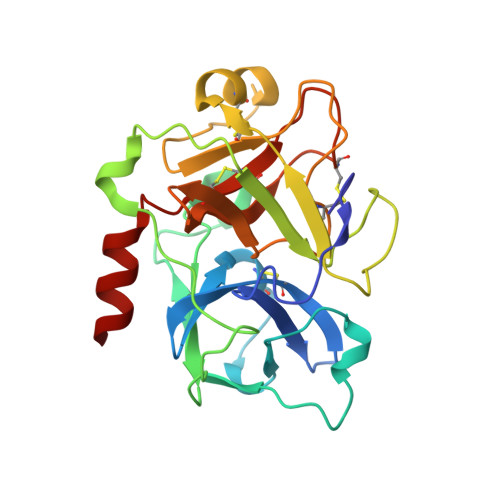Creating Novel Activated Factor Xi Inhibitors Through Fragment Based Lead Generation and Structure Aided Drug Design.
Fjellstrom, O., Akkaya, S., Beisel, H., Eriksson, P., Erixon, K., Gustafsson, D., Jurva, U., Kang, D., Karis, D., Knecht, W., Nerme, V., Nilsson, I., Olsson, T., Redzic, A., Roth, R., Sandmark, J., Tigerstrom, A., Oster, L.(2015) PLoS One 10: 13705
- PubMed: 25629509
- DOI: https://doi.org/10.1371/journal.pone.0113705
- Primary Citation of Related Structures:
4CR5, 4CR9, 4CRA, 4CRB, 4CRC, 4CRD, 4CRE, 4CRF, 4CRG - PubMed Abstract:
Activated factor XI (FXIa) inhibitors are anticipated to combine anticoagulant and profibrinolytic effects with a low bleeding risk. This motivated a structure aided fragment based lead generation campaign to create novel FXIa inhibitor leads. A virtual screen, based on docking experiments, was performed to generate a FXIa targeted fragment library for an NMR screen that resulted in the identification of fragments binding in the FXIa S1 binding pocket. The neutral 6-chloro-3,4-dihydro-1H-quinolin-2-one and the weakly basic quinolin-2-amine structures are novel FXIa P1 fragments. The expansion of these fragments towards the FXIa prime side binding sites was aided by solving the X-ray structures of reported FXIa inhibitors that we found to bind in the S1-S1'-S2' FXIa binding pockets. Combining the X-ray structure information from the identified S1 binding 6-chloro-3,4-dihydro-1H-quinolin-2-one fragment and the S1-S1'-S2' binding reference compounds enabled structure guided linking and expansion work to achieve one of the most potent and selective FXIa inhibitors reported to date, compound 13, with a FXIa IC50 of 1.0 nM. The hydrophilicity and large polar surface area of the potent S1-S1'-S2' binding FXIa inhibitors compromised permeability. Initial work to expand the 6-chloro-3,4-dihydro-1H-quinolin-2-one fragment towards the prime side to yield molecules with less hydrophilicity shows promise to afford potent, selective and orally bioavailable compounds.
Organizational Affiliation:
Medicinal Chemistry, Cardiovascular & Metabolic Diseases Innovative Medicines, AstraZeneca R&D, Mölndal, Sweden.
















